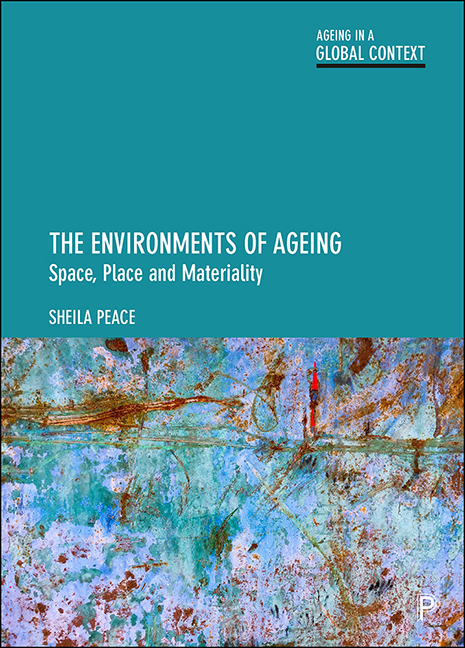Book contents
- Frontmatter
- Dedication
- Contents
- List of figures and tables
- Research summaries
- List of acronyms
- About the author
- Acknowledgements
- Series editors’ preface
- Preface: understanding the structure
- 1 Person and environment
- 2 Theoretical development
- 3 The global context
- 4 Environmental living
- 5 Housing in later life
- 6 Housing histories, housing options
- 7 Alternative environments: specialised housing (with care)
- 8 Care home living: a form of long-term care
- 9 Methodological development
- 10 Rethinking the spatiality of ageing
- Glossary of terms
- References
- Index
4 - Environmental living
Published online by Cambridge University Press: 15 September 2022
- Frontmatter
- Dedication
- Contents
- List of figures and tables
- Research summaries
- List of acronyms
- About the author
- Acknowledgements
- Series editors’ preface
- Preface: understanding the structure
- 1 Person and environment
- 2 Theoretical development
- 3 The global context
- 4 Environmental living
- 5 Housing in later life
- 6 Housing histories, housing options
- 7 Alternative environments: specialised housing (with care)
- 8 Care home living: a form of long-term care
- 9 Methodological development
- 10 Rethinking the spatiality of ageing
- Glossary of terms
- References
- Index
Summary
Introduction
While different dimensions of environment – physical, social, cultural, political – can be considered separately, together they form the environmental context of place that is central to an ecological perspective. Throughout their lives, people live in dynamic interaction with this context, developing psychological understanding of it (Wahl and Lang, 2004; Keating et al, 2013), a view referred to here as ‘environmental living’. Environmental living in later life is the focus of the following five chapters. We move to national (meso-) and local (micro-) scales of reference, using the UK and England as an example, in which locations, settings and situations can be examined. As these scenarios are central to research undertaken by the author and colleagues over the past decades, Chapter 6 forms a bridge to empirical research connecting issues relating to intergenerational and age-related environments. The concept of ‘home’ alongside associated issues of ‘homeland’ is pivotal in this discussion; it is introduced here and is a running theme throughout.
Home and homeland
The word ‘home’ has diverse cultural definitions and is at the heart of a breadth of literature. For many it is a locational term, which is focused on specific housing yet often has a broader base regarding neighbourhood, community, city and nation – connecting with the concept of homeland. This extended definition includes layers of attachment that help to define a person's identity within a particular place. Space and place merge in a meaning of home that is associated with the personal through positive concepts of belonging, security, familiarity and privacy, while sometimes guarding negative concerns regarding gendered domestic activity, non-decent housing, isolation, loneliness and a life of fear or abuse (Peace, 2015).
Consideration of the meaning of home is essential to discussion of the environments of ageing as part of the person– environment (P–E) dynamic, place attachment and the understanding of ageing in place. Chapters 4, 6, 7, 8 reflect on its meaning through physical/built, social, locational and personal aspects to understand how a sense of home embodies the older person through times of continuity, relocation and change. A question raised by the author elsewhere will continue to be considered: ‘Can the ideology of home be re-created throughout later life in any place including non-domestic and age-segregated communal settings?’ (Peace, 2015, p 450).
- Type
- Chapter
- Information
- The Environments of AgeingSpace, Place and Materiality, pp. 73 - 102Publisher: Bristol University PressPrint publication year: 2022

